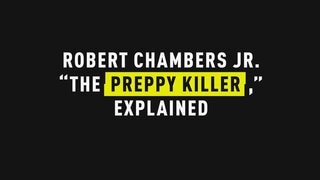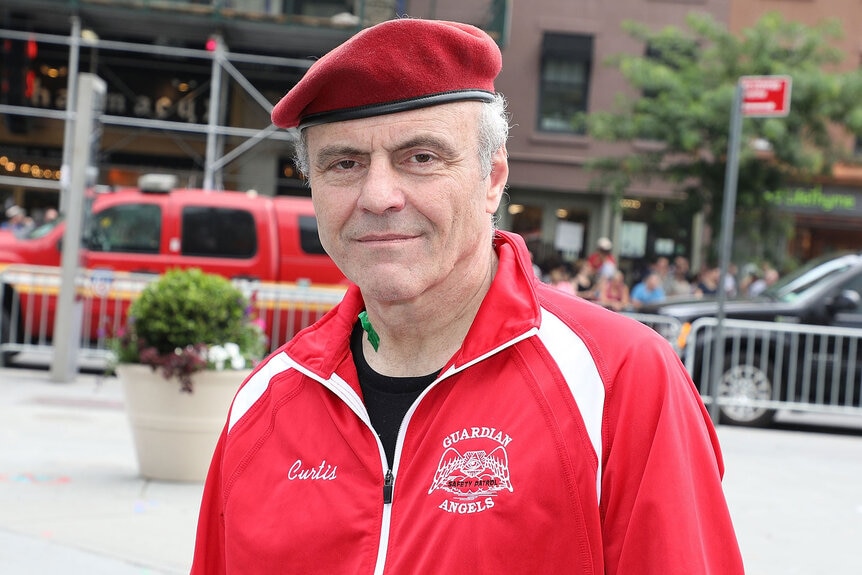Create a free profile to get unlimited access to exclusive videos, breaking news, sweepstakes, and more!
Who Exactly Are The Guardian Angels Featured In 'The Preppy Murder'?
These red-beret capped crusaders patrolled the streets of New York to reduce crime in the city around the time Jennifer Levin was found dead in Central Park.

On the streets of New York, the Guardian Angels see themselves as real-life superheroes of sorts, stepping in to prevent crime on the city’s streets and subways, but instead of a cape, these voluntary crime fighters don red berets.
These citizen crusaders reached their height of popularity in the 1980s — and helped play a pivotal role in the trial of Robert Chambers chronicled in the docu-series “The Preppy Murder: Death in Central Park” — but the organization continues to be active today in 130 different cities across the world, according to the organization’s website.
For the last four decades, the group has sought to reduce crime rates through voluntary safety patrols that are designed to be a visible deterrent to would-be criminals.
“Their efforts help combat the terrifying disease of street crime by uniting citizens together to respond to the ever-changing elements of community problems,” the website states. “They address criminal activity where it is needed most and go beyond the defensive to empower the collective community by teaching practical skills, initiating community programs and emphasizing cooperation to solve problems.”
But the group has not been without controversy — with founder Curtis Sliwa even admitting at one point that some of the group’s crime-fighting victories had actually been staged publicity stunts.
Through it all the group remains and has launched recent efforts to clean up a drug-ravaged park in Staten Island and start a “Perv Busters” crew to identify subway sex crime perpetrators, according to The New York Post.
So, what is its connection to the Robert Chambers trial and "The Preppy Murder" docu-series?
History of The Guardian Angels
The Guardian Angels was formed in 1979 by Sliwa and 12 other volunteers known as the “Magnificent 13” in response to city budget cuts that had reduced the police force leaving some areas of the city — particularly subway cars and platforms — unprotected.
“It was like Jesse James, hold ups on trains,” Sliwa told AM New York earlier this year of the city’s increasing crime during that period. “There was no Uber, there was no Lyft at the time. The people who used the subway, they were middle class, the lower-middle class, the poor….They would constantly be victimized.”
The safety patrols — that began with the 13 original members — quickly grew to include more members patrolling troubled streets and subways.
Many of the members were young black or Latino men who donned the group’s signature red berets and set out to change the stereotype that existed at the time about these young men, Sliwa told The Atlantic in 2017.
“First, we destroyed the stereotype that existed in our city that young black and Latino men or women coming out of the hood had a predisposition to join gangs and be thugs or thugettes,” he said. “That was a very prevalent stereotype. But here emerges the Guardian Angels, predominately black or Hispanic young people who were a total contrast to the gangs.”
Members of the group — which patrolled the streets with 12 to 40 eight-Angel patrols at a time — mostly served as a deterrent to crime just by their presence, but the group would also chase down predators, help those in need, or even pull those who had fallen into the subway’s path back to safety, according to a 1998 profile of the group’s history by The New York Daily News.
The Group’s Link To "The Preppy Murder"
In the mid-1980s, after 18-year-old Jennifer Levin’s body had been found in Central Park, the group launched protests outside of the courthouse where the trial of suspected killer Robert Chambers, claiming the defense team’s strategy to blame the victim for the death had destroyed Levin’s reputation.
Chambers' defense team insisted Chambers accidentally killed Levin after she asked for rough sex, and that it wasn't a murder at all. Subsequently, Levin's sex life was splashed all over the media, with headlines focusing on Chambers' good looks and implying Levin had essentially asked for it.
Chambers’ case and the subsequent media hullabaloo is the subject of the new docu-series “The Preppy Murder: Death in Central Park,” which premiered on AMC and Sundance on November 13.
But not everyone agreed with the salacious articles about Levin: News footage from the time shown in the series depicts the Guardian Angels in their red berets holding signs outside the courthouse that read “Justice For Jennifer” and “No One Gets Away With Murder Not Even Robert.”
“We dislike intensely what he did to Jennifer Levin,” member Lisa Sliwa said at the time in a news clip shown in the series. “We feel he murdered her a second time.”
The group’s support was “wonderful,” according to Levin’s mother, Ellen Levin, who had been furious with the defense’s strategy to paint her daughter in a negative light.
“For months before the trial, they picketed outside, marching, blaming the victim signs in front of the courthouse, and that was very uplifting,” she said in the docu-series.
Sadly, the Guardian Angels were a bit of an anomaly in their public support for Levin and fury with the defense team.
Chambers would end up accepting a plea deal, pleading guilty to manslaughter, and serving 15 years in prison.
Controversy Surrounding The Group
Some in New York saw the Guardian Angels as a welcome element to the city.
“They are a better expression of morality than our city deserves,” Mario Cuomo, who had lost the 1977 mayoral primary to Edward Koch, said of the volunteers, according to The New York Daily News.
Joseph Giacalone, a retired NYPD sergeant who was on the job during the group’s surge in popularity in the 1980s, claimed law enforcement in the city saw the group as a helpful addition.
"They never got in the way," he said, according to AM New York. "They gave people a sense of normalcy, the ability to take a bus or a train and not get robbed."
But Koch, the mayor at the time, did not see it the same way and viewed the group as “paramilitaries.” Other members of law enforcement also voiced their displeasure with the group of beret-capped crusaders.
"We don't need 'em and we don't want 'em," Capt. Gerald McClaughin, commander of the Central Park Precinct, said, according to The Daily News. "Historically, these groups have always turned bad. I think they'll probably assault somebody."
The group came under further scrutiny in 1992 when Sliwa admitted that six of the group’s early crime-fighting victories had actually been staged attempts to get publicity, according to a The New York Times article that year which cited The New York Post.
Sliwa admitted the stunts — including the rescue of a supposed mugging victim and another in which Sliwa claimed he had been injured fighting off several rapists — had been choreographed to draw attention to the group’s good deeds.
But while Sliwa admitted to faking six incidents, other members of the group allege that figure is actually much higher.
Tony Mao, who had been a co-founder of the group, said at the time that he once drenched himself in gasoline and then claimed he had been doused after he tried to stop two men from attacking a clerk working at a token-booth, according to the New York Times.
“We believed the lie,” he said, claiming the stunt had been planned by Sliwa. “We told the stories so much we convinced ourselves.”
There were also varying accounts at the time about just how many members the group actually had. Those who spoke out against Sliwa claimed there were really only about 30 volunteers who mainly focused their efforts at the time on protecting an area of midtown restaurants.
But Sliwa disputed those claims, maintaining the group had about 150 members — with nearly a hundred more joining their forces in the city’s warmer months.
That same year Sliwa made that admission, he was shot multiple times in what was believed to be a mob hit orchestrated by the Gambino family’s John Gotti, according to The New York Post.
Despite the controversy and Sliwa’s near death experience, the group continued on, although the group would never again reach the peak membership numbers of the 1980s.
The Guardian Angels Today
In 2016, after a series of slashings in the subways, the group announced a renewed effort to keep the city’s subway system safe.
“We doubled down, we increased our recruitment, and we began to focus on those neighborhoods that were the feeding system for the slashings,” Sliwa told The Atlantic.
The organization also started a new group known as the Perv Busters aimed at alerting police and educating women about suspected sexual offenders who expose themselves or commit other acts of sexual misconduct in the city’s busy subway system.
“Often, we are provided pictures of them that victims took with their cellphones. We’ll do informational outreach in which we print up thousands of flyers and spread them throughout the system and then immediately begin pursuing them—something the local authorities just don’t do. It’s almost like out of sight, out of mind,” Sliwa told The Atlantic.
The group is mostly comprised of women who are tired of seeing other women victimized.
“We’ve gotten a lot of guys caught,” member Mary “K.C.” Gethins told AM New York of group’s work. “We don’t always get credit for it, but that’s not what we do it for.”
The Guardian Angels has also now spend more resources on community service and outreach initiatives, like the Junior Guardian Angels Community Service Center, where members watch students do homework and offer classes in areas like the martial arts.
“We’re just trying to get them to be good citizens, not necessarily Guardian Angels,” Dennis “Super Stretch” Torres, who runs the cente,r told AM New York.
While a lot has changed over the last four decades, the Guardian Angels' commitment to fighting crime and improving the city remains — and it will always be remembered for being one of the entities that stuck up for Jennifer Levin after she was killed.















